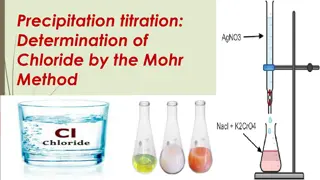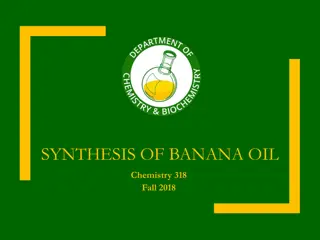Chapter 26: Amides and Amines
Explore the characteristics and reactions of amides and amines through a detailed presentation accompanying "Organic and Biochemistry Supplement to Enhanced Introductory College Chemistry." Learn about the distinct odour of fish, nucleophilic acyl substitution reactions, functional groups of amides,
1 views • 48 slides
Dust Control Products and Their Environmental Impact: An Analysis
In the battle against dust, dust control products have become commonplace. However, the environmental consequences of these seemingly innocuous solutions often go unnoticed. Due to high chloride concentrations leaching into our environment, salinization remains a serious threat to North American fre
0 views • 1 slides
Dust Control Products and Their Environmental Impact: An Analysis
In the battle against dust, dust control products have become commonplace. However, the environmental consequences of these seemingly innocuous solutions often go unnoticed. Due to high chloride concentrations leaching into our environment, salinization remains a serious threat to North American fre
0 views • 9 slides
Solubility Rules from the University of South Carolina
This resource outlines the solubility rules for various compounds based on their chemical properties. It explains the solubility of compounds of alkali metals, ammonium salts, nitrates, chlorides, sulfates, and more. The rules provide insights into which compounds are soluble or insoluble in aqueous
1 views • 10 slides
Overview of Acyl Chlorides in Organic Chemistry
Acyl chlorides, also known as acid chlorides, are important compounds in organic chemistry. They can be prepared from carboxylic acids and thionyl chloride, and are reactive towards various nucleophiles leading to the formation of carboxylic acid esters, primary and secondary amides. Acyl chlorides
0 views • 5 slides
Determination of Chloride by Mohr Method
Precipitation titration is a volumetric method used for determining chloride ions. Mohr's method involves reacting alkaline or alkaline earth chlorides with silver nitrate in the presence of a potassium chromate indicator. The endpoint of the titration is signaled by the appearance of red silver chr
0 views • 9 slides
Role of Major Physiological Anions in the Human Body
Physiological anions such as chlorides, sulphates, bicarbonate, phosphates, and electrolytes play essential roles in maintaining various functions within the body. Chloride ions help in osmotic balance, charge balance, and acid-base balance. Sulphates are important for detoxification mechanisms and
0 views • 11 slides
Understanding the Pinacol-Pinacolone Rearrangement in Organic Chemistry
The Pinacol-Pinacolone rearrangement is a crucial process in organic chemistry for converting 1,2-diols into carbonyl compounds. This rearrangement involves a 1,2-migration under acyl conditions, resulting in the shift of two adjacent atoms. Learn about the mechanisms, products, and uses of Pinacolo
0 views • 11 slides
Organic Chemistry Reactions and Synthesis Overview
Explore a comprehensive overview of organic chemistry reactions, including esterification, oxidation, hydroboration, and reductions like Wolff-Kishner and Clemmensen. Dive into compound classifications such as carboxylic acids, ketones, and acid chlorides. Learn about key reagents and reactions esse
0 views • 23 slides
Synthesis of Banana Oil in Chemistry Class
The synthesis of banana oil involves a reaction between carboxylic acid and alcohol catalyzed by H2SO4 to produce isoamyl acetate. The mechanism includes nucleophilic acyl substitution with two main reaction steps - addition and elimination. The process shifts the equilibrium to favor product format
0 views • 16 slides









